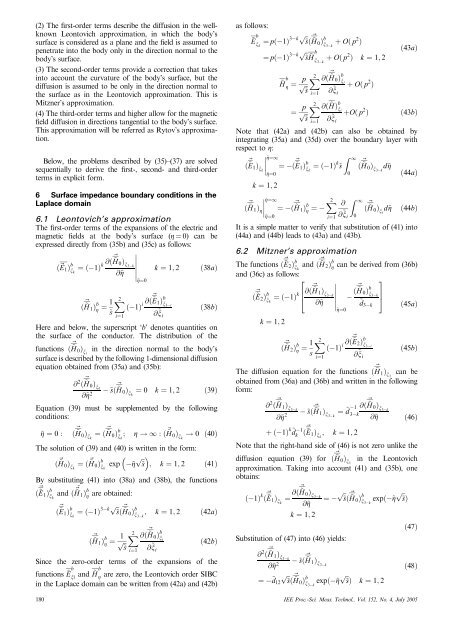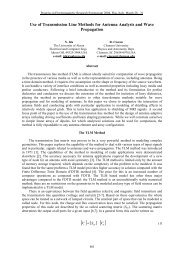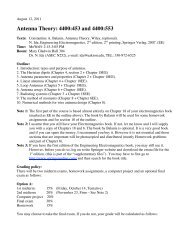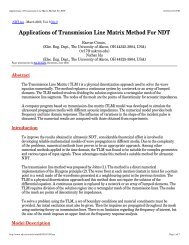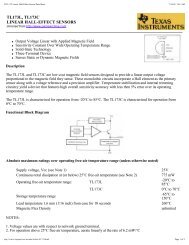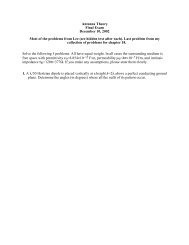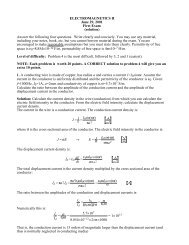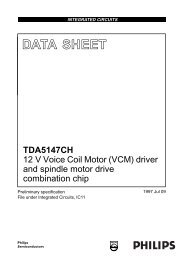Time domain surface impedance concept for low frequency ...
Time domain surface impedance concept for low frequency ...
Time domain surface impedance concept for low frequency ...
You also want an ePaper? Increase the reach of your titles
YUMPU automatically turns print PDFs into web optimized ePapers that Google loves.
(2) The first-order terms describe the diffusion in the wellknown<br />
Leontovich approximation, in which the body’s<br />
<strong>surface</strong> is considered as a plane and the field is assumed to<br />
penetrate into the body only in the direction normal to the<br />
body’s <strong>surface</strong>.<br />
(3) The second-order terms provide a correction that takes<br />
into account the curvature of the body’s <strong>surface</strong>, but the<br />
diffusion is assumed to be only in the direction normal to<br />
the <strong>surface</strong> as in the Leontovich approximation. This is<br />
Mitzner’s approximation.<br />
(4) The third-order terms and higher al<strong>low</strong> <strong>for</strong> the magnetic<br />
field diffusion in directions tangential to the body’s <strong>surface</strong>.<br />
This approximation will be referred as Rytov’s approximation.<br />
Be<strong>low</strong>, the problems described by (35)–(37) are solved<br />
sequentially to derive the first-, second- and third-order<br />
terms in explicit <strong>for</strong>m.<br />
6 Surface <strong>impedance</strong> boundary conditions in the<br />
Laplace <strong>domain</strong><br />
6.1 Leontovich’s approximation<br />
The first-order terms of the expansions of the electric and<br />
magnetic fields at the body’s <strong>surface</strong> (Z ¼ 0) can be<br />
expressed directly from (35b) and (35c) as fol<strong>low</strong>s:<br />
ð~E 1 Þ b x k<br />
¼ð 1Þ k @ð~ ~H 0 Þ x3 k<br />
@~Z<br />
k ¼ 1; 2 ð38aÞ<br />
<br />
~Z¼0<br />
X 2<br />
ð ~ ~H 1 Þ b Z ¼ 1 ð 1Þ i @ð~ ~E 1 Þ b x 3 i<br />
~s<br />
i¼1 @ ~ ð38bÞ<br />
x i<br />
Here and be<strong>low</strong>, the superscript ‘b’ denotes quantities on<br />
the <strong>surface</strong> of the conductor. The distribution of the<br />
functions ð ~ ~H 0 Þ xi<br />
in the direction normal to the body’s<br />
<strong>surface</strong> is described by the fol<strong>low</strong>ing 1-dimensional diffusion<br />
equation obtained from (35a) and (35b):<br />
@ 2 ð ~ ~H 0 Þ xk<br />
@~Z 2 ~sð ~ ~H 0 Þ xk<br />
¼ 0 k ¼ 1; 2 ð39Þ<br />
Equation (39) must be supplemented by the fol<strong>low</strong>ing<br />
conditions:<br />
~Z ¼ 0 : ð ~ ~H 0 Þ xk<br />
¼ð ~ ~H 0 Þ b x k<br />
; Z !1: ð ~ ~H 0 Þ xk<br />
! 0 ð40Þ<br />
Thesolutionof(39)and(40)iswritteninthe<strong>for</strong>m:<br />
ð ~ ~H 0 Þ xk<br />
¼ð ~ p<br />
~H 0 Þ b x k<br />
exp ~Z ~s<br />
ffiffi <br />
; k ¼ 1; 2 ð41Þ<br />
By substituting (41) into (38a) and (38b), the functions<br />
ð ~ ~E 1 Þ b x k<br />
and ð<br />
~~H ~ 1 Þ b Z<br />
are obtained:<br />
ð ~ pffiffi<br />
~E 1 Þ b x k<br />
¼ð 1Þ 3 k ~<br />
~s ð H 0 Þ b x 3 k<br />
; k ¼ 1; 2 ð42aÞ<br />
ð ~ ~H 1 Þ b Z ¼ p 1 ffiffi<br />
X2 @ð ~ ~H 0 Þ b x i<br />
~s<br />
i¼1 @ ~ ð42bÞ<br />
x i<br />
Since the zero-order terms of the expansions of the<br />
functions ~E b xi and ~H b Z are zero, the Leontovich order SIBC<br />
in the Laplace <strong>domain</strong> can be written from (42a) and (42b)<br />
as fol<strong>low</strong>s:<br />
~E b pffiffi<br />
x k<br />
¼pð 1Þ 3 k ~<br />
~s ð H 0 Þ b x 3 k<br />
þ Oðp 2 Þ<br />
p ffiffi<br />
¼pð 1Þ 3 k ~s H ~ b x 3 k<br />
þ Oðp 2 Þ k ¼ 1; 2<br />
~H b Z ¼ p ffiffi<br />
X2 @ð ~ ~H 0 Þ b x i<br />
~s<br />
i¼1 @ ~ þ Oðp 2 Þ<br />
x i<br />
ð43aÞ<br />
¼ p ffiffi<br />
X2 @ð ~HÞ b x i<br />
~s<br />
i¼1 @ ~ þOðp 2 Þ ð43bÞ<br />
x i<br />
Note that (42a) and (42b) can also be obtained by<br />
integrating (35a) and (35d) over the boundary layer with<br />
respect to Z:<br />
ð ~ <br />
~Z¼1<br />
~E 1 Þ xk<br />
¼ ð ~ Z 1<br />
~E 1 Þ b x k<br />
¼ð 1Þ k ~s ð ~ ~H 0 Þ x3 k<br />
d~Z<br />
~Z¼0<br />
0<br />
ð44aÞ<br />
k ¼ 1; 2<br />
ð ~ <br />
~Z¼1<br />
~H 1 Þ Z<br />
¼ ð ~ ~H 1 Þ b Z ¼ X2<br />
~Z¼0<br />
i¼1<br />
Z<br />
@ 1<br />
@ ~ ð ~ ~H 0 Þ xi<br />
d~Z<br />
x i<br />
0<br />
ð44bÞ<br />
It is a simple matter to verify that substitution of (41) into<br />
(44a) and (44b) leads to (43a) and (43b).<br />
6.2 Mitzner’s approximation<br />
The functions ð ~ ~E 2 Þ b x k<br />
and ð ~ ~H 2 Þ b Z<br />
can be derived from (36b)<br />
and (36c) as fol<strong>low</strong>s:<br />
2<br />
ð ~ ~E 2 Þ b x k<br />
¼ð 1Þ k @ð ~ ~H 1 Þ x3 k<br />
ð ~ 3<br />
6<br />
~H 0 Þ b x 3 k 7<br />
4<br />
@~Z<br />
5<br />
~d 3 k ð45aÞ<br />
~Z¼0<br />
k ¼ 1; 2<br />
ð ~ ~H 2 Þ b Z ¼ 1 s<br />
X 2<br />
i¼1<br />
ð 1Þ i @ð~ ~E 2 Þ b x 3<br />
@ ~ x i<br />
i<br />
ð45bÞ<br />
The diffusion equation <strong>for</strong> the functions ð ~ ~H 1 Þ x1<br />
can be<br />
obtained from (36a) and (36b) and written in the fol<strong>low</strong>ing<br />
<strong>for</strong>m:<br />
@ 2 ð ~ ~H 1 Þ x3 k<br />
@~Z 2 ~sð ~ ~H 1 Þ x3 k<br />
¼ d ~ 1 @ð ~ ~H 0 Þ x3<br />
3 k<br />
@~Z<br />
þð 1Þ k ~ d<br />
1<br />
k ð ~ ~E 1 Þ xk<br />
; k ¼ 1; 2<br />
k<br />
ð46Þ<br />
Note that the right-hand side of (46) is not zero unlike the<br />
diffusion equation (39) <strong>for</strong> ð ~ ~H 0 Þ x1<br />
in the Leontovich<br />
approximation. Taking into account (41) and (35b), one<br />
obtains:<br />
ð 1Þ k ð ~ ~E 1 Þ xk<br />
¼ @ð~ ~H 0 Þ x3 k<br />
@~Z<br />
k ¼ 1; 2<br />
¼<br />
Substitution of (47) into (46) yields:<br />
pffiffi<br />
~ p<br />
~s ð H 0 Þ b x 3 k<br />
expð ~Z ~s<br />
ffiffi Þ<br />
ð47Þ<br />
@ 2 ð ~ ~H 1 Þ x3 k<br />
~sð ~ ~H<br />
@~Z 2 1 Þ x3 k<br />
ð48Þ<br />
¼ d ~ pffiffi<br />
~ p<br />
12 ~s ð H 0 Þ b x 3 k<br />
expð ~Z ~s<br />
ffiffi Þ k ¼ 1; 2<br />
180 IEE Proc.-Sci. Meas. Technol., Vol. 152, No. 4, July 2005


